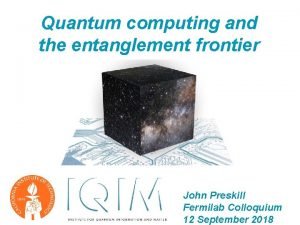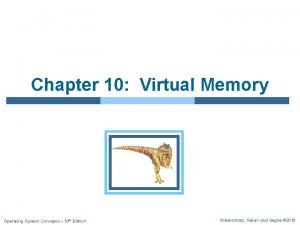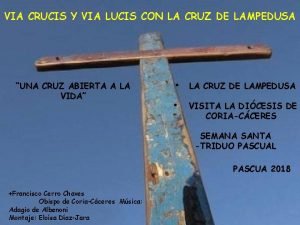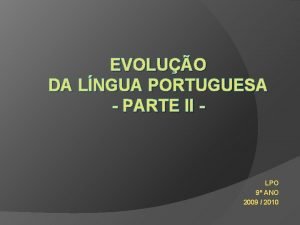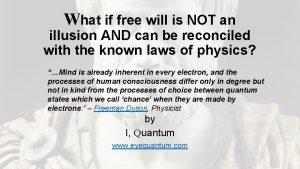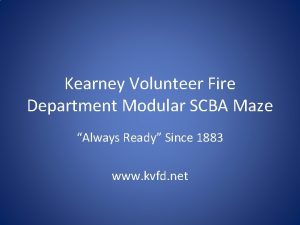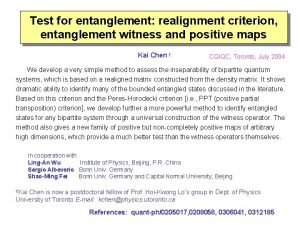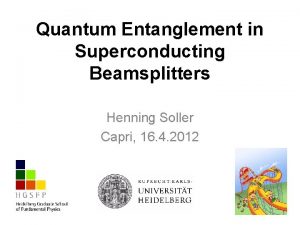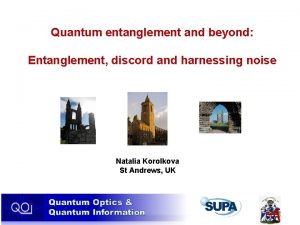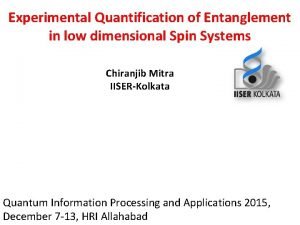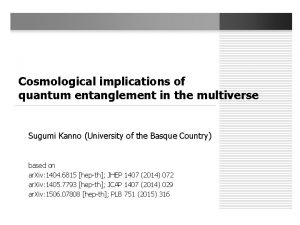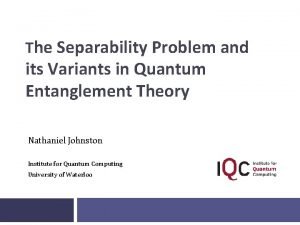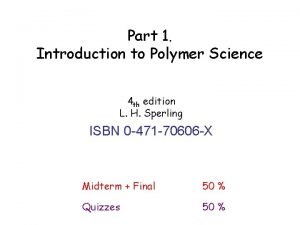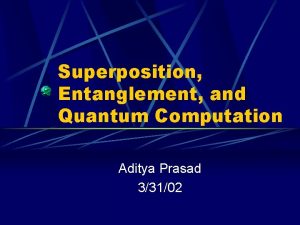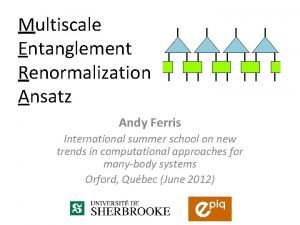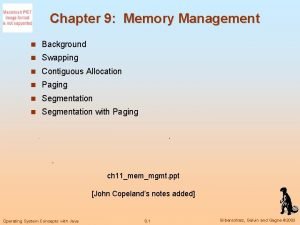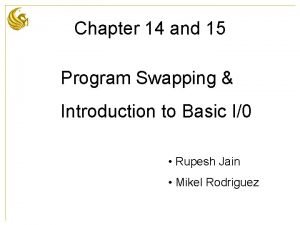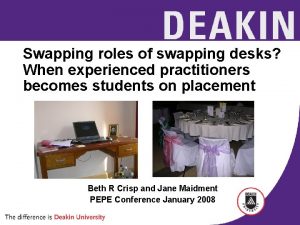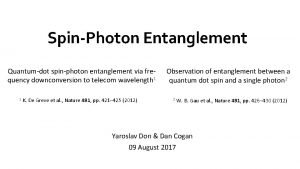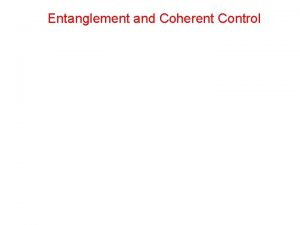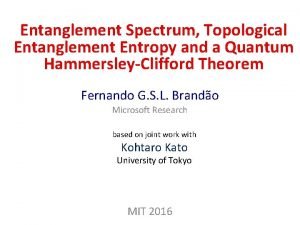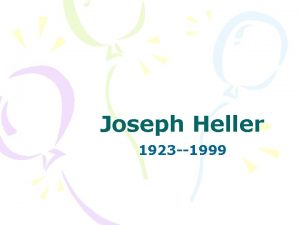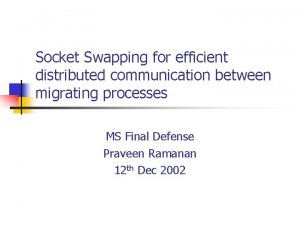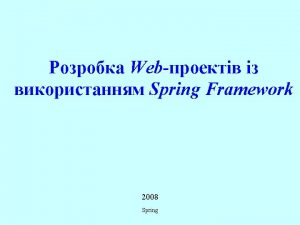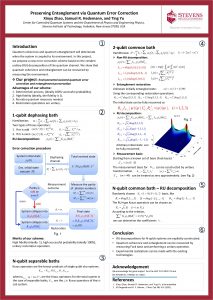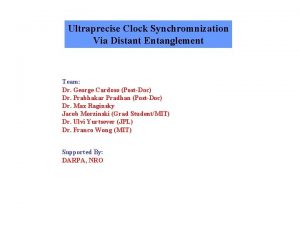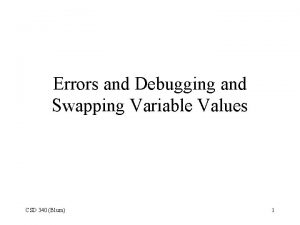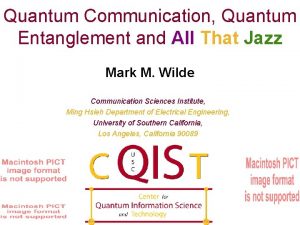Entanglement and Entanglement Swapping Joseph Spring Communication via























- Slides: 23

Entanglement and Entanglement Swapping Joseph Spring

Communication via Qubits

States and Superposition Standard cbits are represented as vectors in a Hilbert Space These may be used to form either the Z basis or the X basis From which qubits are formed as a superposition of their basis vectors Recall: Schrodingers Cat In Quantum world: Cat both Dead and Alive In Classical world: Cat Dead or Alive after measurement 3

BB 84 1. Alice chooses (4 +δ )n random data bits a where n >> m the length of the sought key 2. Alice chooses a (4 +δ )n random - bit string b. She encodes each data bit as {|0>, |1>} if the corresponding bit of b is 0 or {|+>, |->} b is 1 3. Alice sends the resulting state to Bob 4. Bob receives the (4 +δ )n qubits, announces this fact, and measures each qubit in the X or Z basis at random 5. Alice announces b 6. Alice and Bob discard any bits where Bob measured a different basis than Alice prepared. With high probability there at least 2 n bits left (if not abort the protocol). They keep 2 n bits. Lecture - Definition and Motivation

BB 84 7. Alice selects a subset of n bits that serve as the ‘check bits’, a check on Eves interference, and tells Bob which bits were selected 8. Alice and Bob announce and compare the values of the n ‘check bits’. If more than an acceptable number disagree then they abort the protocol 9. Alice and Bob perform information reconciliation and privacy amplification on the remaining n bits to obtain m shared key bits Lecture - Definition and Motivation

B 92 We consider what happens to one bit at a time. Generalisation to a block follow naturally as with BB 84 1. Alice prepares one random classical bit a, and depending upon the result sends Bob 2. Depending upon the random classical bit a’ that Bob generated, Bob uses either the Z or X basis and obtains his result b - which is either a 0 or a 1 Lecture - Definition and Motivation

B 92 3. Bob announces b but keeps a’ secret 4. Alice and Bob conduct a public discussion keeping only those pairs {a, a’} for which b = 1. Note that when a = a’, then b = 0. Only when a’ = 1 – a does b = 1 and this occurs with probability ½ 5. The final key is a for Alice and 1 – a’ for Bob Lecture - Definition and Motivation

Communication via Qubits Parties share EPR pairs but communication is via a classical bit channel

Teleportation H Measure n Measure m Xm Zn A gate based circuit for teleporting a state from sender to receiver 9

Multipartite States For multipartite states we have vectors of the form With corresponding density operators In which This leads us to the concept of entanglement, a major resource in QIP (Quantum Information Processing) 10

Teleportation H Measure n Measure m Xm Zn A gate based circuit for teleporting a state from sender to receiver 11

Entangled States – Major Resource Two fundamental views • Algebraically no common vector factors, irreducible, prime states • Correlation View – Entangled photons are seen to be correlated or anticorrelated (both spin up or both spin down as opposed to one spin up and the other spin down) • Examples: • Bell states, GHZ states, W states • Partial entanglement for subsystems of a general system also used 12

Gate Based • A gate based quantum circuit is one in which a series of unitary (self inverse) operators (matrices) are applied and possibly followed by a final measurement to obtain a classical outcome • The unitary operators can, for example, involve the Pauli gates, the Hadamard, CNOT, Phase gates, … • Examples • generating Bell states • Teleportation H CNOT I A gate based circuit for generating a Bell state 13

Teleportation • Sender has unknown quantum state that they wish to send to a receiver • Cannot measure (generally changes the state) or take copies (No Cloning Theorem) • Resource: Sender and Receiver share • an EPR channel (Bell state) • and a classical channel 14

Teleportation H Measure n Measure m Xm Zn A gate based circuit for teleporting a state from sender to receiver 15

Teleportation Protocol 16

Teleportation 17

Communication via Qubits Parties share EPR pairs and communicate via qubits

Entanglement Swapping • Satellite generates two entangled Bell states, one at A and one at D • One of the two photons at A is sent to B; and likewise one is sent from D to C A B Router 1 D Satellite C Router 2 19

Entanglement Swapping Let and such that denote two Bell states with denotes entanglement between A and B and denotes entanglement between C and D. Then We consider the case for 20

Entanglement Swapping Let denote the state vector for the system. Then Taking a Bell measurement w. r. t AD (local) we obtain a particular (global) Bell state w. r. t BC 21

Entanglement Swapping • Taking a local measurement of the two satellite photons at A and D results in establishing a global EPR channel between B and C A B Router 1 D Satellite C Router 2 22

Quantum Heterogeneity • Quantum Networks • Fibre Optic Networks, Free Space Networks, Cavity – QED Networks • DARPA QKD Network (2001), • SECOQC QKD Network (Vienna) Secure Communication based on Quantum Cryptography, (2003) • Tokyo QKD Network, (2009) • Hierarchical Network, Wuho, China, (2009) • Geneva Area Network (Swiss. Quantum) • Shanghai – Beijing 2000 km Network (2016) • Quantum Hardware • Quantum Operating Systems • Cambridge Quantum Computing (CQCL) new o/s t|ket> • Quantum Programming Languages • Quantum Imperative Paradigm • Quantum Pseudocode, QCL - Quantum Computing Language, Q Language, q. GCL, Lan. Q, Qiskit • Quantum Functional Paradigm • QFC, QPL, QML, Quipper Lecture - Definition and Motivation
 Via positiva and via negativa
Via positiva and via negativa Four seasons korean movie
Four seasons korean movie Spring is green summer is bright autumn is yellow
Spring is green summer is bright autumn is yellow Quantum computing and the entanglement frontier
Quantum computing and the entanglement frontier A process is busy swapping pages in and out. *
A process is busy swapping pages in and out. * Decimoquinta estacion del via crucis
Decimoquinta estacion del via crucis Via lucis las 14 estaciones
Via lucis las 14 estaciones Marcha helicopoda
Marcha helicopoda Via erudita e via popular
Via erudita e via popular Is free will an illusion
Is free will an illusion Firefighter maze plans
Firefighter maze plans Entanglement witness
Entanglement witness Entanglement strategy
Entanglement strategy Henning soller
Henning soller Discord
Discord Quantum discord
Quantum discord Chiranjib mitra
Chiranjib mitra Multiverse (entangled)
Multiverse (entangled) Quantum entanglement
Quantum entanglement Polymer entanglement
Polymer entanglement Entanglement vs superposition
Entanglement vs superposition Mera
Mera Swapping ch 9
Swapping ch 9 Swapping manga 14
Swapping manga 14



